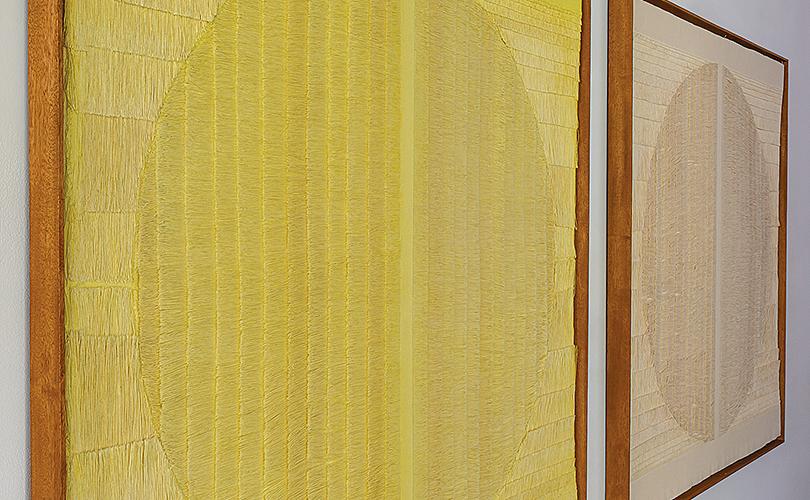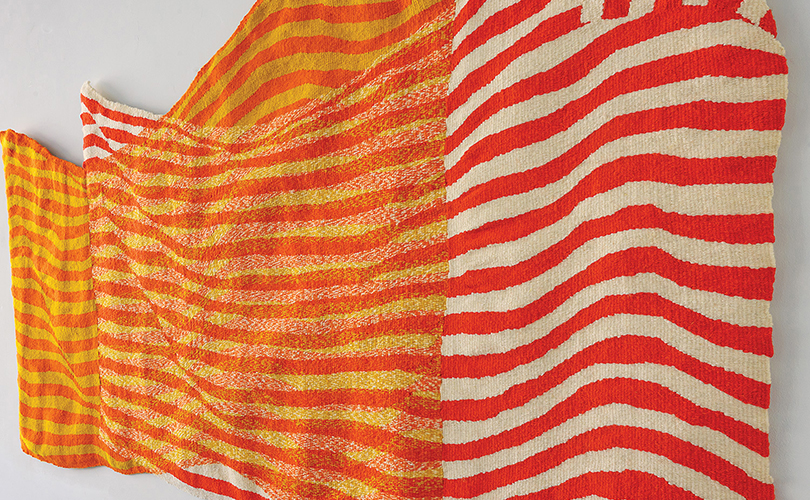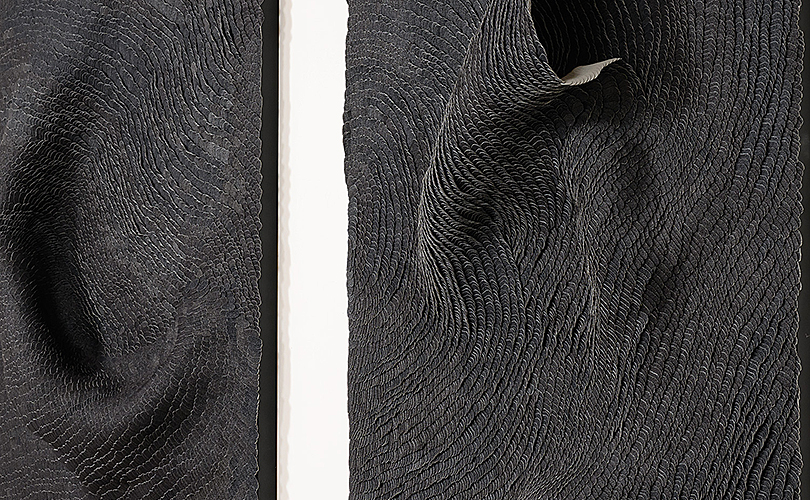
We are just three days out from the Artist Reception and Opening for Field Notes: an art survey at browngrotta arts in Wilton, CT (March 3 – 11). Field Notes is our state-of-the-art look at fiber art and artists at a time when the medium is surging in popularity. As part of our review, we’ve invited some artists, new to browngrotta arts, to participate. Among them are three — Sophie Rowley, from New Zealand and Germany, Yong Joo Kim, who works in both Seoul, Korea and Chicago, and Misako Nakahira, from Japan — who make arresting works that hang on, and emerge from, the wall. Like the other artists we champion at browngrotta arts, these three are experimenters — educated in textile technique, who have then stepped away from the expected to innovate with unique materials and approaches.
Sophie Rowley creates two-dimensional works or textile “paintings” made from yarn. In a recent interview with Tique: publication on contemporary art, Rowley described her focus: “People often assume I’m a weaver, but I am actually an ‘unweaver.’ Using self-developed techniques, I produce pieces that are mostly complex and detailed, yet are minimal in their aesthetic, and that explore the relationship between light and shadow. Through techniques of deconstruction, I dismantle the weave in a careful and calculated way, challenging the inherent structure and tangible qualities of the canvas. My overall approach is evolutionary, in the sense that bodies of work often emerge from an unexpected mistake or experimental shift in an earlier work series.” (“Six questions for Sophie Rowley,” Tique: publication on contemporary art: https://tique.art/interviews/six-questions/sophie-rowley/.)
Rowley’s family wasn’t particularly interested in art, she says. However, she had always been interested in painting, drawing, sewing which her parents strongly encouraged. “When I majored in art in high school, my art teacher had a significant impact on me,” she told Tique, “I remember being introduced to Christo and Jeanne-Claude in her class—artists who still inspire me and remain among my favorites to this day.”

Five years ago, Misako Nakahira began creating stripe-themed tapestries, inspired by reading Michel Pastoureau’s The Devil’s Cloth: A History of Stripes (Atria Books, New York, New York 2003). Pastoreaus’s book explores the history of stripes in Western culture from the Middle Ages to the present day. Originally, stripes served as markers in medieval Europe, identifying individuals affected by plagues or those ostracized by society, such as prisoners and prostitutes. They symbolized heresy and negative connotations, he notes. “To stripe a surface serves to distinguish it, to point it out, to oppose it or associate it with another surface, and thus to classify it, to keep an eye on it, to verify it, even to censor it.” Pastoureau concludes the book by stating that “stripes are patterns that establish order between people and space.”
Stripes are typically seen as parallel lines that never intersect, symbolizing infinity, Nakahira notes. When the artist started her work amidst the global COVID-19 pandemic, she was struck by how people maintained a sense of order in their lives while occasionally clashing. She sought to represent this dynamic through stripes and imagined a future where such challenging circumstances would not last forever. As a result, the stripes in her work feature deliberate distortions and overlaps, reflecting these experiences. Nakahira also references the phenomenon of the “echo chamber” in her work. On social media, people encounter similar opinions, creating the illusion of intersecting orders among individuals who have never met in person. Nakahira projects this social phenomenon onto her overlapping stripes. Her works often incorporate the colors yellow and orange, which, like stripes, signify “caution.” The layers created by the two stripe patterns may appear to clash or harmonize depending on perspective, yet neither pattern dominates the other. Nakahira believes that using stripes as a motif—a universally understood and versatile form of expression—provides a way to view society from a broader perspective and interpret the times. The works in Field Notes, Towels-O and Interaction, are based on these familiar motifs.

1-2yjk Isolation No.1: 32 Days and No.2: 21 Days
hook-and-loop fasteners on wood, 36” x 24” x 6” each, 2023. Photo by Tom Grotta
“I make art motivated by the pressure and weight I feel to take personal responsibility for my survival as an artist,” Yong Joo Kim says. “By sublimating the pressure and weight I feel from mere emotion into a visible method of fabrication, I wish to share how beautiful and valuable human manifestation of ‘responsibility-taking’ can be.”
Kim’s method of transforming emotion into art is quite remarkable. Trained as a metalsmith, Kim changed her repertoire from precious metals while a graduate student at the Rhode Island School of Design, to explore the world of unnoticed objects. She has pioneered the use of velcro hook-and-loop fasteners, cutting out pieces of fasteners, then growing them in scale by attaching them together as if to make fabric. From that point, “my process evolves in unpredictable ways,” she says, “guided by two primary methods: applying pressure with my hands and adding weight by hanging and rotating the work on the wall.” What results are striking works featuring chasms and eruptions that suggest natural forms like canyons and mountains.
“What I’ve learned from practicing this approach, is that pressure and weight — often perceived as threatening — can breathe new life and energy into the creative process when harnessed as a method of work.” Kim says that for her, making art is less a means of expression and more a residue of her efforts to sustain her life under pressure and weight. “I hope this work is seen not merely as a sculptural object,” she says, “but also as a symbol of resilience, beauty, and the transformation of struggle into creation.” She invites viewers to reflect on their own lives, encouraging them to recognize how the pressure and weight they bear can be reshaped.
Join us next week to see the work of these accomplished artists and that of 50 others!
Exhibition Details:
Field Notes: an art survey
browngrotta arts
276 Ridgefield Rd
Wilton, CT 06897
May 3 – 11, 2025
Gallery Dates/Hours:
Saturday, May 3rd: 11am to 6pm [Opening & Artist Reception]
Sunday, May 4th: 11am to 6pm (40 visitors/ hour)
Monday, May 5th through Saturday, May 10th: 10am to 5pm (40 visitors/ hour)
Sunday, May 11th: 11am to 6pm [Final Day] (40 visitors/ hour)
Safety protocols:
Reservations strongly encouraged.
In June
Join us for Art on the Rocks: an art talkthrough with spirits! Field Notes edition
On Zoom
June 10, 2025, 7 pm EST
